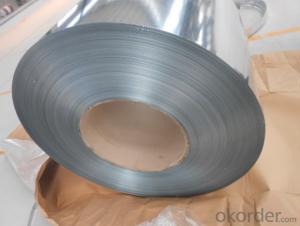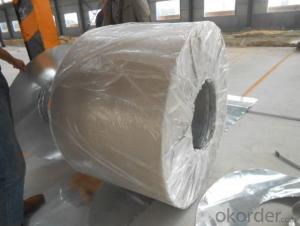JIS G 3302 GALVANIZED STEEL COILS WITH LOW PRICE
- Loading Port:
- Tianjin
- Payment Terms:
- TT OR LC
- Min Order Qty:
- 25.00 m.t.
- Supply Capability:
- 10000 m.t./month
OKorder Service Pledge
OKorder Financial Service
You Might Also Like
Prime Galvanized steel coil
Packaging & Delivery
Packaging Detail: seaworthy export package
Delivery Detail: on request
Specifications
1. more than 10 years’ experience on this field
2. advanced equipments
3. competitive price
4. soonest delivery
Product Description :
Commodity
Hot dip galvanized steel coil
Technical Standard: JIS 3302 / ASTM A653 / EN10143/ GB/T 2518
Grade:DX51D/ S250,280,320GD,SGCC,SGHC,SGH340,SGH400,SGH440,G450,G550
Types:Commercial / Drawing / Deep Drawing / Structural quality
Width: 900mm/1000mm/1219mm/1200mm/1220mm/1250mm
Thickness: 0.2mm~4.0mm
Type of coating: galvanized
Zinc coating: Z40-275g/m2,Z40-Z450g/m2
Surface treatment: zero spangle / regular spangle/ big spangle
ID coil: 508mm or 610mm
Coil weight: 3-10/MT per coil
Package: Properly packed for ocean freight exportation in 20''container
Application:: home appliances, constructions, building, machineries
Our Advantages :
1. Expertise:
More than 10 years of manufacture: we know how to properly handle every step of production.
2. Competitive price:
We can offer competitive prices to our customers.
3. Accuracy:
We have excellent technicians and leaders, which can ensure our products are exactly what you want.
4. Materials:
All galvanized steel coils are made of high-quality raw materials.
5. Certificate:
Our products are certified by ISO9001.
6. Productivity:
We have large-scales of production lines,, which can guarantee all your orders will be finished in earliest time.
Hr CGL Technical Process:
Coil loading-> uncoiling-> cutting-> welding-> entry accumulator-> Heating and deoxidization-> galvanizing-> air cooling->water quenching-> air dryer-> tension leveler-> Passivation->air dryer->exit accumulator-> oiling-> cutting-> recoiling->coil unloading-> packing
The furnace heating style: improved Sendzimir heating technology
Hourly output: max.76.3t/h
Process after coating: tension leveling, Passivation or oiling
Our Service
Our quality
Test Equipments of Prepainted Galvanized Steel Coil : Salt-spray tester; Atomic absorption spectrophotometer; Rockwell typer hardness tester; Tensile test machine; Metrohm titration; Laboratory Bend test machine.
Our packing
Properly packed for ocean freight exportation in 20''container, galvanized metal fluted rings on inner and outer edges, galvanized metal & waterproof paper wall protection disk, galvanized metal & waterproof paper around circumference.
R&D department
R&D department concentrates on researching and developing reliable products with best quality. The quality department test and control every process of production to guarantee the best quality of products
- Q:How are steel coils used in the production of electrical transmission towers?
- Steel coils are used in the production of electrical transmission towers in various ways. Firstly, steel coils are often used to manufacture the structural components of the towers, such as the main support columns and crossarms. These components need to be strong and durable to withstand the weight and stress of the transmission lines, and steel coils provide the necessary strength and stability. Additionally, steel coils are also used to fabricate the brackets and braces that reinforce the transmission towers. These brackets and braces help to distribute the load evenly and provide additional support to the structure. Steel coils can be easily shaped and welded into the required forms, making them ideal for creating these intricate components. Moreover, steel coils are commonly used to create the foundation and anchor bolts that secure the transmission towers to the ground. These bolts need to be strong and resistant to corrosion, as they play a crucial role in maintaining the stability and integrity of the entire tower structure. Steel coils are often treated with galvanization or other protective coatings to enhance their durability and prevent rusting. Overall, steel coils are an essential material in the production of electrical transmission towers due to their strength, durability, and versatility. They enable the construction of sturdy tower structures that can support the weight of the transmission lines and withstand various environmental conditions.
- Q:Hey guys do you know anything about Steel Arch Building and how this structure really looks like?
- Steel Arch buildings consist of arched steel panes and can be erected very easily in minimal time. Steel Arch buildings can be used for both agricultural and industrial purposes. They come in the shape of an arch which serves the dual purpose of both the roof and the wall. after constructing it you can get 100% useable clear span space! No poles, beams or trusses are required for it. We can call it do-it-yourself construction cause most buildings are erected in just a few days with help from family or friends.
- Q:How are steel coils inspected for chemical composition using spectroscopy?
- Spectroscopy techniques such as X-ray fluorescence (XRF) and laser-induced breakdown spectroscopy (LIBS) can be employed to examine the chemical makeup of steel coils. XRF involves directing an X-ray beam onto the surface of the steel coil, prompting the sample's atoms to emit distinct X-ray fluorescence radiation. By examining the energy and intensity of these emitted X-rays, one can determine the elemental composition of the steel. This method is both rapid and non-destructive, enabling swift and accurate assessment of the steel coil's chemical composition. On the other hand, LIBS entails focusing a laser beam onto the steel coil's surface, generating a high-temperature plasma. The plasma emits light, which is subsequently collected and analyzed using a spectrometer. This emitted light contains characteristic atomic and ionic emissions, allowing for the identification and quantification of various elements present in the steel. LIBS is also a non-destructive technique, providing real-time results and requiring minimal sample preparation. Both XRF and LIBS offer multiple benefits in terms of speed, non-destructiveness, and user-friendliness for inspecting the chemical composition of steel coils. These spectroscopic techniques play a vital role in quality control and assurance, ensuring that the steel meets the necessary specifications and standards for diverse industrial applications.
- Q:what is tool steel and does it function better than carbon or spring steel?
- Yes, its good for machining, but it needs to be hardened once machined. Steel in itself is very weak, but when tempered it can become 10x stronger. Once shaped, heat the sword with a torch until it starts to change color, then dip it into a vat of oil, not water, and the rapid cooling when reform the atoms of the steel. Heres an article about the process:
- Q:How are steel coils used in the production of rail tracks?
- Steel coils are used in the production of rail tracks as they are a primary raw material for manufacturing the rails. These coils are first processed to form the desired shape and dimensions of the rail tracks, which are then cut, welded, and shaped to create the individual rail sections. The steel coils provide the strength, durability, and flexibility necessary for the tracks to withstand heavy loads, extreme weather conditions, and constant use.
- Q:How are steel coils used in the manufacturing of automotive suspension systems?
- Steel coils are used in the manufacturing of automotive suspension systems as they provide the necessary support and resistance to absorb shocks and vibrations. These coils, also known as coil springs, are typically positioned between the vehicle's frame and the suspension system to enhance stability and ensure a smooth ride.
- Q:What are the different types of edge conditions in steel coils?
- Some of the different types of edge conditions in steel coils include mill edge, slit edge, and sheared edge. Mill edge refers to the original edge produced during the steel manufacturing process. Slit edge is created when the steel coil is cut into narrower strips. Sheared edge is formed when the coil is trimmed using a cutting tool. These various edge conditions have different characteristics and can impact the usability and appearance of the steel coils.
- Q:how much pressure can steel withstand? and how much pressure can concrete withstand? per m3 or cm3? thanks
- About all I remember is concrete can stand tremendous compression but almost no stretch .
- Q:How are steel coils used in the production of telecommunications equipment?
- Steel coils are commonly used in the production of telecommunications equipment as they provide structural support and durability. These coils are used to create various components of telecommunications equipment, such as cabinets, racks, and enclosures. One important application of steel coils in telecommunications equipment is the manufacturing of cabinets. These cabinets house the sensitive electronic components and wiring used in telecommunications systems. Steel coils are typically formed and shaped to create the structure of these cabinets, providing a sturdy and reliable housing for the equipment. The steel material also provides protection against external factors like impacts, dust, and moisture, ensuring the longevity and integrity of the telecommunications equipment. Steel coils are also utilized in the production of racks for telecommunications equipment. These racks are designed to hold multiple pieces of equipment, such as servers, switches, and routers, in an organized and accessible manner. The strength and rigidity of steel coils make them an ideal material for constructing these racks, ensuring that they can bear the weight of multiple devices and withstand the constant handling and movement that occurs in telecommunication environments. Furthermore, steel coils are used to manufacture enclosures for telecommunications equipment. Enclosures are protective casings that shield sensitive electronic components from external influences like electromagnetic interference and physical damage. Steel coils are often formed into specific shapes and sizes to create these enclosures, providing a robust barrier that safeguards the equipment from various external threats. In summary, steel coils play a crucial role in the production of telecommunications equipment by providing structural support, durability, and protection. They are used to create cabinets, racks, and enclosures, which ensure the proper functioning and longevity of the sensitive electronic components used in telecommunication systems.
- Q:What are the different types of steel coil packaging materials for export?
- Some of the different types of steel coil packaging materials for export include wooden crates, steel crates, steel frames, steel racks, plastic wrapping, and cardboard boxes. These packaging materials are chosen based on the weight and dimensions of the steel coils, as well as the specific requirements of the export destination.
1. Manufacturer Overview |
|
|---|---|
| Location | |
| Year Established | |
| Annual Output Value | |
| Main Markets | |
| Company Certifications | |
2. Manufacturer Certificates |
|
|---|---|
| a) Certification Name | |
| Range | |
| Reference | |
| Validity Period | |
3. Manufacturer Capability |
|
|---|---|
| a)Trade Capacity | |
| Nearest Port | |
| Export Percentage | |
| No.of Employees in Trade Department | |
| Language Spoken: | |
| b)Factory Information | |
| Factory Size: | |
| No. of Production Lines | |
| Contract Manufacturing | |
| Product Price Range | |
Send your message to us
JIS G 3302 GALVANIZED STEEL COILS WITH LOW PRICE
- Loading Port:
- Tianjin
- Payment Terms:
- TT OR LC
- Min Order Qty:
- 25.00 m.t.
- Supply Capability:
- 10000 m.t./month
OKorder Service Pledge
OKorder Financial Service
Similar products
New products
Hot products
Hot Searches
Related keywords





























